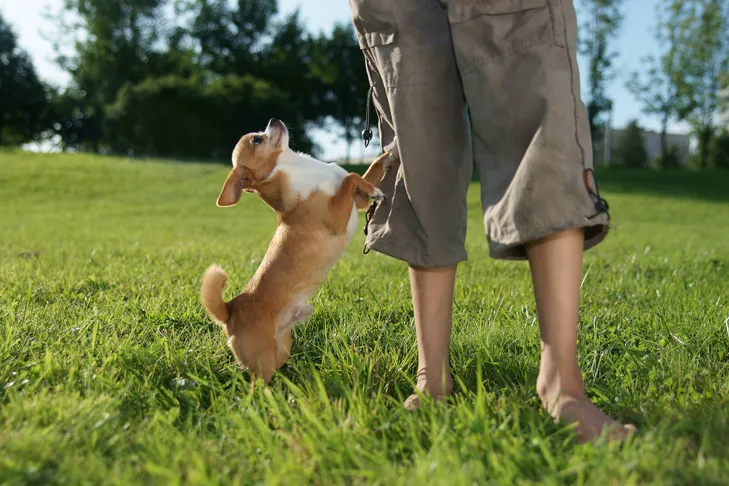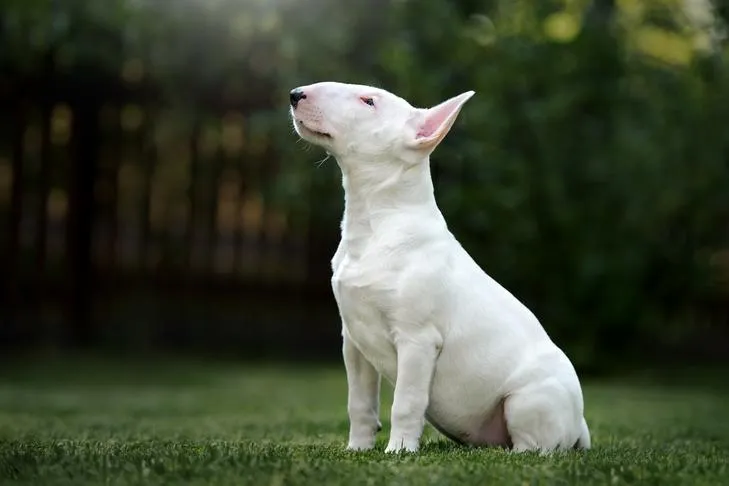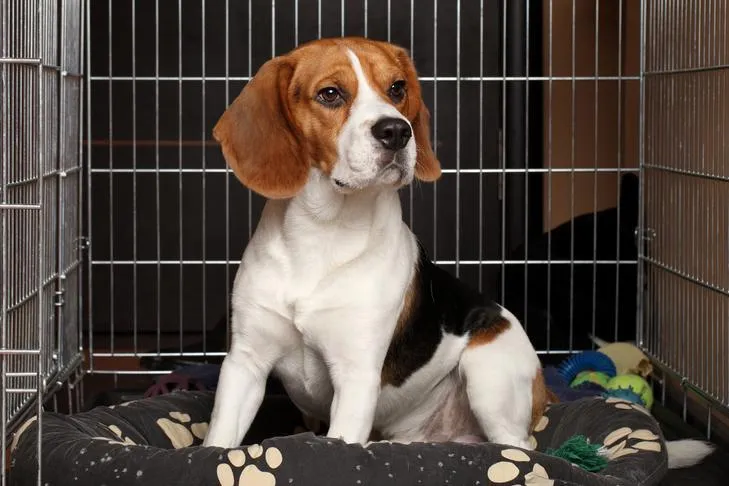Jumping up to greet people is an instinctive behavior for many dogs. It’s their way of getting face-to-face attention and initiating interaction, often reinforced by enthusiastic (even if unintended) responses from humans. While your dog’s intentions are usually friendly, this behavior can be inconvenient, messy, and even dangerous, particularly for children, the elderly, or those with mobility issues. Muddy paw prints on clean clothes, scratched skin, or even being knocked over are common issues dog owners face. Teaching your dog polite greeting manners is crucial for their safety, the safety of others, and for fostering a harmonious relationship between your dog and the people they meet.
Understanding Why Dogs Jump
Dogs are masters at repeating behaviors that consistently yield rewards, and for many canines, few things are more rewarding than human attention. When a dog jumps, they almost always receive some form of attention, whether it’s a gentle pat, a verbal command, or even a push away. This interaction, even if negative from a human perspective, serves as a reinforcement for the dog. They learn that jumping is an effective way to get noticed. Family members, visitors, and even strangers can unknowingly perpetuate this cycle by giving attention when the dog jumps. For some dogs, the act of being pushed away can even be misinterpreted as an invitation to a playful wrestling game, further cementing the undesirable behavior. To successfully teach your dog not to jump, you must break this cycle of reinforcement and provide clear, rewarding alternatives. Understanding common understanding puppy behavior can help in identifying these early habits.

Training Alternative Greeting Behaviors
Simply ignoring a dog when they jump might seem like a straightforward solution, as it removes the reward (attention). However, it’s often impractical, as not every person your dog encounters will understand or adhere to this rule. More importantly, simply telling your dog “no” or ignoring them doesn’t teach them what they should do instead. Dogs thrive on clear communication and positive reinforcement. The most effective strategy involves teaching an alternative, polite behavior that your dog can perform to receive the attention they desire. Whether you prefer your dog to keep “four on the floor” or to sit calmly during greetings, the key is to be consistent and reward the desired action.
How to Train “Four on the Floor” Greetings
This method focuses on preventing jumping by rewarding your dog for keeping all four paws on the ground before they even have a chance to leap up. It requires quick action and anticipation on your part.
- Preparation: Have your dog on a leash and a willing helper approach. Prepare a handful of highly desirable treats.
- Anticipate and Reward: As your helper approaches but before they reach your dog, toss several treats directly onto the floor near your dog. This encourages your dog to focus downward, engaging their nose and mouth.
- Engage and Praise: While your dog is busy eating the treats off the floor, have your helper calmly pet and greet them.
- Disengage: Before your dog finishes eating all the treats, have your helper turn and walk away.
- Repetition and Extension: Repeat these steps multiple times. Gradually, you can extend the duration of the greeting by continuously tossing treats onto the floor as long as your dog remains calm with all four paws down.
- Fade the Treats: Once your dog consistently keeps four paws on the ground, allow them to greet the person before placing the first treat. The greeting itself becomes part of the reward. Over time, you can feed fewer and fewer treats until the polite greeting and attention are the primary rewards.
The success of this technique hinges on your speed. You must anticipate your dog’s jumping impulse and provide the treats before they can jump. If your dog does jump, immediately have the person turn and walk away, and stop giving treats. Your dog will quickly learn that “four on the floor” brings attention and treats, while jumping makes the attention disappear. This principle of rewarding desired behavior is fundamental, much like using effective puppy potty training.

How to Train “Sit” for Greetings
Teaching your dog to sit when greeting people is another excellent alternative. This method teaches your dog that a calm, seated posture is the key to receiving attention.
- Initial Setup: Tether your dog’s leash to a sturdy object like a doorknob or heavy piece of furniture. This prevents them from jumping or running away during the exercise.
- Approach and Sit: From a few feet away, ask your dog to “sit.” If they comply, calmly approach them. If they stand up or attempt to jump, immediately turn your back and walk away to your starting point, then ask for the “sit” again.
- Reward Calmness: If your dog remains sitting as you approach, gently praise and pet them. The moment they stand up, immediately turn and walk away, ending the interaction.
- Increase Excitement: As your dog masters sitting for greetings with you, gradually increase the level of excitement in your approach. Use a slightly more enthusiastic voice or body language, but always retreat if they break the sit.
- Generalize with Others: Once your dog reliably sits for your greetings, repeat these steps with friends and family members. This helps generalize the behavior to different people and environments.
A strong “sit” command is the foundation for this exercise. Ensure your dog can sit reliably in various situations and with minor distractions before introducing it for greetings. Encourage your dog to sit for daily routines, such as before going outside or receiving dinner, to reinforce that “sit” is a polite way to ask for things. Consistent practice with house training tricks also builds a dog’s general obedience.
 Cute Bull Terrier puppy sitting patiently in a green yard, demonstrating desired polite greeting behavior.
Cute Bull Terrier puppy sitting patiently in a green yard, demonstrating desired polite greeting behavior.
Preventing Jumping While Training is Underway
While actively training new greeting behaviors, it’s essential to manage your dog’s environment to prevent them from practicing the unwanted jumping. Every instance of jumping is a chance for the behavior to be reinforced, slowing down your training progress.
- Doorbell Management: If your dog has a strong “go to your place” cue, send them to their mat or crate when the doorbell rings. This keeps them safely contained and prevents opportunities for jumping.
- Physical Barriers: Install a dog gate at your entranceway. This allows your dog to see and hear visitors without being able to physically jump on them. This is an important step in successful puppy potty training too, as it manages access.
- Leash Control: Keep your dog on a leash when guests arrive. This provides you with direct control to guide them into a sit or keep all four paws on the floor.
- Distraction Tools: Keep a stash of toys and treats near your front door. When a visitor arrives, you can toss a treat or toy away from the doorway to occupy your dog as your guest enters. Alternatively, you can hand a treat to your guest to reward your dog for calm behavior upon greeting.
- Controlled Outdoor Greetings: Preventing jumping can be especially challenging when walking your dog, as you can’t expect strangers to know your training rules. Until your dog reliably greets friends and family politely, it’s best to avoid having them greet strangers. Instead, use a “watch me” cue or squeak a toy to get their attention as people pass by. Once your dog is ready for public greetings, clearly communicate your training procedure to interested strangers, asking them to ignore your dog if they don’t follow the rules. This is also important when working on advanced skills like off-leash walking skills.
 Alert Beagle sitting calmly inside its open crate, showing focused obedience and readiness for training.
Alert Beagle sitting calmly inside its open crate, showing focused obedience and readiness for training.
Conclusion
Teaching your dog not to jump on people requires patience, consistency, and a clear understanding of canine behavior. By implementing positive reinforcement techniques and proactively managing their environment, you can guide your dog toward more appropriate and enjoyable greeting behaviors. Remember, the goal is not to suppress your dog’s enthusiasm but to channel it into polite and safe interactions. With dedicated training, your dog will soon learn to say hello in a way that is welcomed by everyone, whether at your front door or out on a walk.
